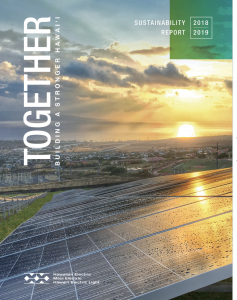Hawaiian Electric Releases Sustainability Report
The Hawaiian Electric Companies released their 12th annual Sustainability Report for 2018-19, describing efforts to address climate change, enhance community resilience and sustainability, and move Hawai‘i closer to 100% clean energy by 2045, or sooner.
The companies’ renewable portfolio standard (RPS) in 2018 was 27%, up from 9% a decade ago. Had the Puna Geothermal Venture plant on Hawai‘i Island remained online throughout the year, the companies’ RPS for 2018 would have reached 29%.
According to a new public opinion survey, residents are seeing progress. Pacific Resource Partnership asked 942 registered voters about issues affecting the state in February 2019 and found, “Residents give high marks to Hawai‘i’s progress on renewable energy.” Out of 11 social or policy issues raised, it was the only one where respondents said they saw improvement.
The next four years, 2019 through 2022, are expected to bring even more significant movement in the transition from fossil fuels to renewables and the reduction in greenhouse gas emissions.
Highlights include:
- Grid-scale solar, now about 150 megawatts (MW) across the five islands served by the companies, is expected to nearly quadruple through 2022. Private rooftop solar will remain the largest renewable resource, with growth of about 25% by 2022. Energy storage, key to optimum use of variable resources like solar and wind, will continue to grow rapidly, with more than 1 gigawatt coming online in the next several years.
These resources and others will ensure the Hawaiian Electric Companies exceed the required RPS of 30% in 2020 and are close to 70% by 2030.
- Renewable generation, storage and incentives for customers to shrink or shift electricity use will reduce the amount of oil imported to generate electricity. Since 2008, the companies have reduced their consumption by 88 million gallons a year and through 2022 consumption is forecast to fall another 134 million gallons.
- Carbon-dioxide emissions are forecast to decrease by 1.6 million tons in 2022. Burning coal for electricity generation will cease in 2022 with the end of the contract between Hawaiian Electric and AES Hawai‘i, the state’s only coal-fired plant.
In 2018, the nationally recognized Smart Electric Power Alliance (SEPA) named Hawaiian Electric, Maui Electric and Hawai‘i Electric Light the 2018 Investor-Owned Utilities of the Year and Maui Electric was a finalist for the Visionary of the Year award.
These awards capture some of the progress detailed in the 24-page report Sustainability Report, which is available online at: https://www.hawaiianelectric.com/sustainability https://www.mauielectric.com/sustainability https://www.hawaiielectriclight.com/sustainability.
Among other highlights:
• 2018 RPS levels were:
o Hawai‘i Electric Light, at 44%, down from 57% in 2017. It would have reached 64% if PGV was online for the full year
o Maui Electric, 38%, up from 34% in 2017
o Hawaiian Electric, 22%, up from 21% in 2017
Typically on sunny, windy days, well over half the electricity that customers use comes from renewables. The peak on Maui was 80% on April 14, 2018. It was 79% on Hawai‘i Island on April 14, 2018 and 58% on O‘ahu on May 19, 2018.
In addition, privately-owned, customer-sited rooftop solar continued to grow in 2018 with nearly 4,000 new systems, increasing the percentage of residential customers with solar from 17% in 2017 to 18% in 2018. That is more than twice second-place Connecticut with 6.8% and third-place California with 5.9%.
The Sustainability Report also explains the companies’ vision beyond electricity and getting off fossil fuels. It includes using technology and ingenuity to build smart, sustainable, resilient communities. The report also details the companies’ volunteer work and corporate and individual contributions, including 3,800 pounds of food and nearly 950 units of blood.















